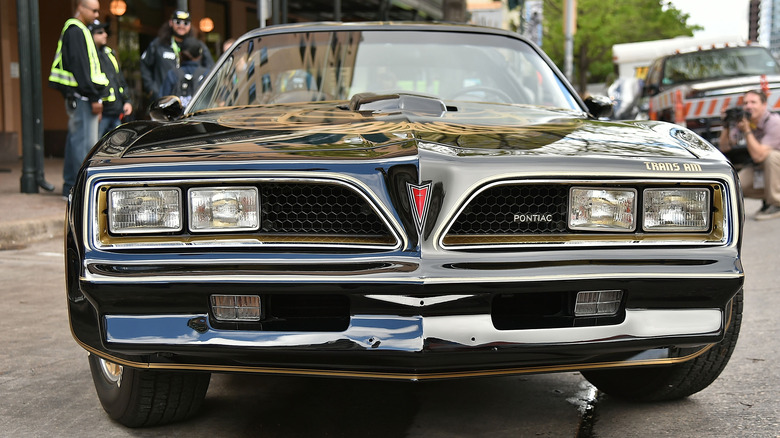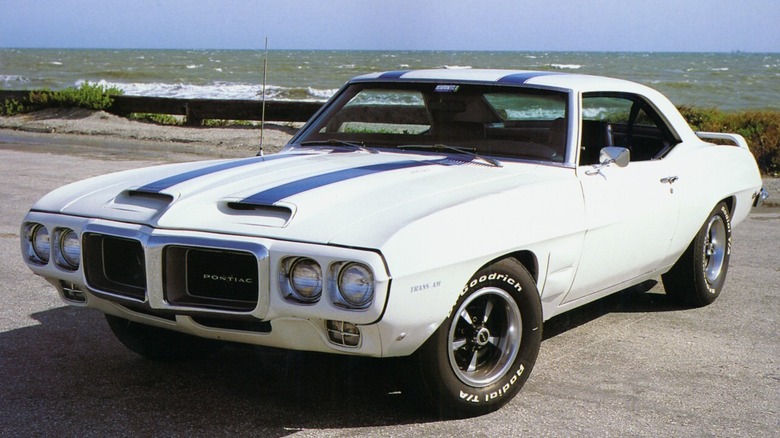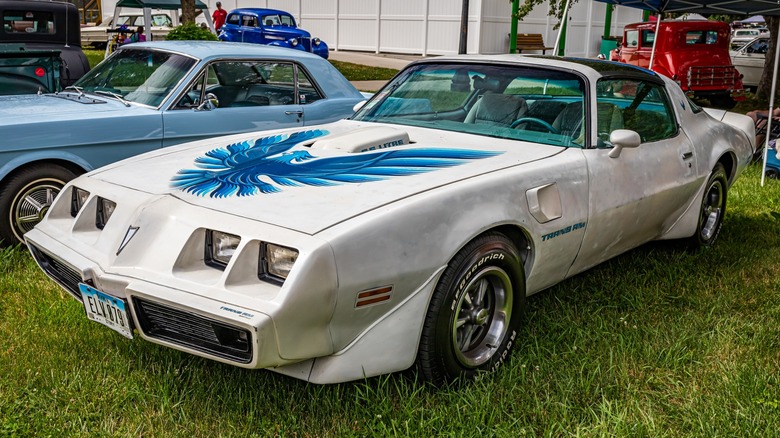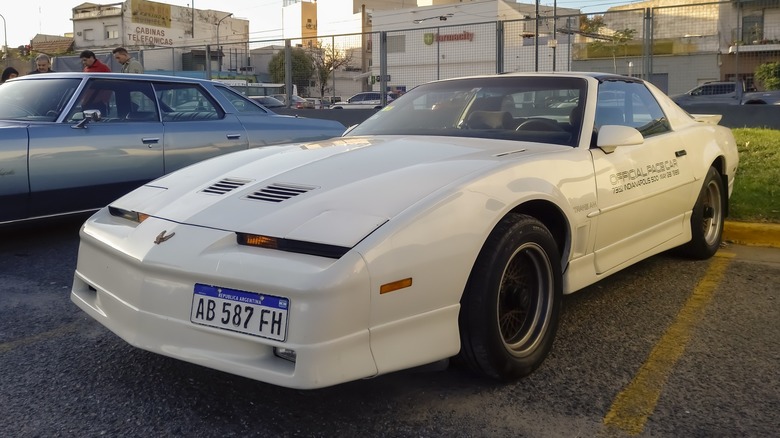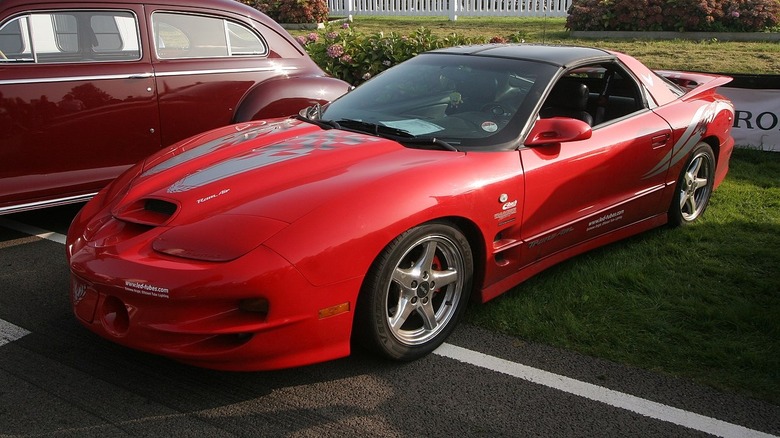What's The Difference Between Pontiac Trans Am And Firebird?
When it comes to classic American muscle cars, you've likely heard the names "Firebird" and "Trans Am." Classic Pontiacs have a well-earned reputation among aficionados of American steel and a proud impact on pop culture, with starring roles in movies like John Wayne's "McQ" and the motorhead classic "Smokey and The Bandit."
However, what some folks might not be aware of is the fact that the Firebird and Trans Am brands are much more closely related than one might think. In fact, to some extent, they are the same car. There is, after all, a reason the Trans Am often has a massive graphic on the hood of what certainly looks like a fiery bird. The Trans Am is a high-performance variant of the Firebird that Pontiac first offered as a specialty package in 1969. Pontiac would produce four great and not-so-great generations of the Firebird before finally nixing the model in 2002.
Firebird vs. Trans Am Throughout the Years
The 1969 Pontiac Firebird came in several setups. The Firebird 250 and 350 got their names from the displacement of their straight-six engines, 250 and 350 cubic-inch plants delivering 175 and 265 hp respectively. Sportier models boasted a fearsome 335-hp V8 that would make Pontiac one of the defining builders of big-block engines. The very top of the line was the Trans Am package.
The name is shorthand for the Trans-American Cup racing series staged by the Sports Car Club of America. Pontiac even paid the $5 SCCA royalty for buyers to take their Trans Ams racing. Alongside that mighty V8, the Trans Am came with upgraded suspension, a heavy-duty stabilizer bar, and variable power steering to optimize its on-track performance. All 1969 Trans Am models were white with blue racing stripes and came with aero upgrades, including hood scoops to vent the engine bay and an airfoil in the rear for downforce. 1969 was the first and only year of the first-gen Pontiac Firebird Trans Am.
The first-gen Firebird and Trans Am were also available as convertibles. However, the convertible option went away with the second-gen release and wouldn't make a comeback for decades.
Second-gen Firebird and Trans Am
1970 brought the second generation of the Pontiac Firebird and, thus, the second generation of the Trans Am. The car went through a redesign that did away with the four headlight front end, opting for two to make space for bigger air intakes up front. Along with it came the Pontiac 455 V8 as an option for the Firebird. However, this generation spanned the 1970s oil crisis, stricter emissions regulations, and the switch to unleaded gasoline, all of which meant reduced power across U.S. vehicles of the era.
The second-gen Trans Am initially came with the Pontiac 400 like the 1969 models and eventually got the 455 as well. Later in the 1970s, Pontiac would try a new, turbocharged 4.9-liter V8. That sounds great, but it only made 210 horsepower and was available exclusively with the three-speed automatic transmission. At least the second-gen Trans Am got an improved suspension over the standard Firebird to optimize it for on-track performance.
Despite its lack of power, the second-gen Trans Am is perhaps the most recognizable of them all, being the iconic model from car chase classic "Smokey and the Bandit." The Trans Am made that movie the second-highest grossing film of 1977. The only movie that beat it was "Star Wars."
Third-Generation Firebird and Trans Am
The third-gen Firebirds and Trans Ams were introduced in 1982 and continued production through 1992. Engineers turned their eyes toward making the car more efficient by way of aerodynamics and weight reduction. The result was a much smaller car that came in several hundred pounds lighter than second-gen models. However, the regulations that throttled the second-gen's power output also plagued this generation. On the low end, the 1982 Firebird came with a lowly 90-horsepower "Iron Duke" four-cylinder. Even the V8-powered top model only managed 245 hp, comparable to a midrange model from the 1960s. Almost the only good news was that the drop-top came back: 1991 brought back the convertible Firebird for the first time since 1969.
Given the restrictions in place, the Trans Am didn't have much running room for added power. However, it did still see suspension advantages over the standard Firebird models for improved handling. The biggest difference between the Firebird and Trans Am for this generation was its aesthetics. Pontiac designers gave it matte gray wheel covers, door handles, dual mirrors, and other exterior components for a more "high-tech" and "modern" look.
Fourth-Generation Firebird and Trans Am
The fourth and final Firebird generation spanned model years 1993 to 2002 and saw a drastic modernization and redesign. Initially, the fourth-gen Firebird came with either a 3.4-liter V6 or the 5.7-liter LT1 V8. From 1996, the base V6 engine was bumped up to the 200 horsepower 3.6-liter V8. The most notable upgrade for the final generation of Firebirds came in 1998, when the classic marque finally got the ferocious General Motors LS1 engine. Other modernizations included safety features like airbags and ABS.
The Trans Am saw the usual suspension advantages over the standard Firebird models. Adding the WS6 package, available from 1996, saw more aggressive styling and more power. The pinnacle of the fourth-gen Trans Am was the 2002 WS6 model, which would be both the Firebird's 35th anniversary and its last hurrah. It paired the aggressive WS6 styling with a 325 horsepower LS1, making it the most powerful Trans Am since 1971. A stock model of the last Trans Am sprinted from zero to 60 MPH in 5.4 seconds and ran a quarter-mile in just 13.
